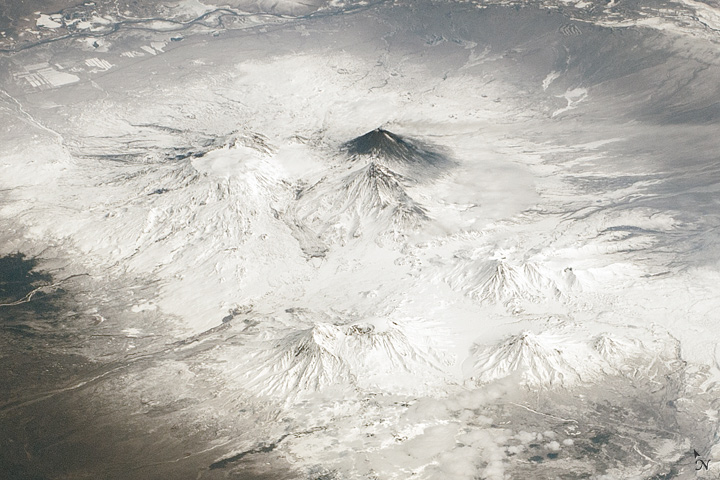Volcanoes Dot Snowy Russian Landscape in New Photo from Space

The ashy peak of a volcano stands out amid a snowy scene, hinting at a recent eruption, in newly released images from NASA.
The Kamchatka Peninsula, in eastern Russia, is one of the most active volcanic regions on Earth, and the ash-covered Klyuchevskoy volcano erupts most frequently. The volcano formed 6,000 years ago and hasn't slowed down since, according to NASA.
The image, which shows a thin plume of ash and steam flowing out of the Klyuchevskoy volcano, was captured by an astronaut aboard the International Space Station in early May. Klyuchevskoy is flanked by other snow-covered volcanoes, including Ushkovsky, Bezymianny and Tolbachik, according to NASA. [Images: Erupting Kamchatka Volcanoes]
There are 300 known volcanoes on the Kamchatka Peninsula, 29 of which are thought to be active. The region also has mineral springs, hot springs and geysers, according to NASA. Klyuchevskoy volcano soars 15,593 feet (4,753 meters), Ushkovsky volcano ascends 12,933 feet (3,942 m), Tolbachik volcano climbs 11,844 feet (3,610 m) and Bezymianny volcano rises 9,453 feet (2,881 m).
The peninsula extends about 750 miles (1,200 kilometers), which is equivalent to the coastline of Hawaii, and formed when the Pacific ocean plate slid beneath the Eurasia continental plate in a tectonic process called subduction, according to NASA. The volcanoes on Kamchatka are part of the so-called Ring of Fire, a narrow chain of volcanoes that circle the Pacific Ocean, where a large number of the planet's earthquakes and volcanic eruptions occur.
The Kamchatka Peninsula is surrounded by the sea and has a moist, relatively mild climate that allows lush vegetation to flourish. Land animals such as bears, snow rams, northern deer, sables and wolverines roam the region, while birds like sea eagles, white-tailed eagles, golden eagles, gyrfalcons and peregrine falcons soar above. The abundant and distinct flora and fauna led UNESCO to designate the Volcanoes of Kamchatka a World Heritage Site in 1996. Regular monitoring of the volcanoes started in 1935 with the founding of the Kamchatka Volcanological Station in Petropavlovsk-Kamchatsky.
Elizabeth Goldbaum is on Twitter. Follow Live Science @livescience, Facebook & Google+. Original article on Live Science.
Get the world’s most fascinating discoveries delivered straight to your inbox.

 Live Science Plus
Live Science Plus





